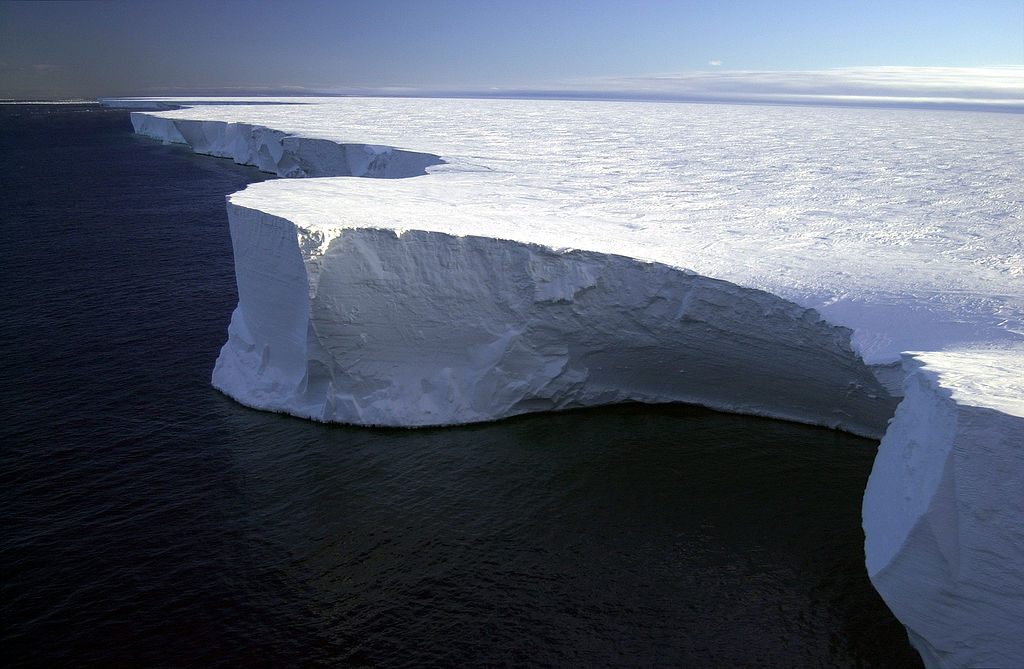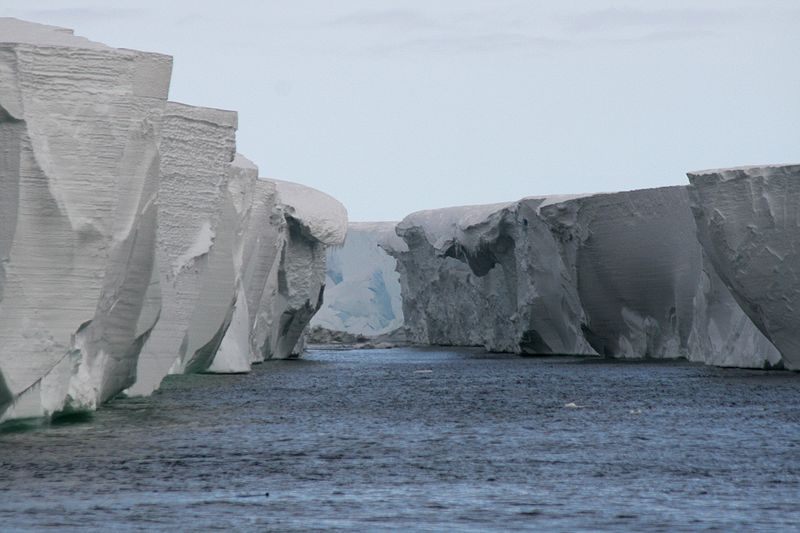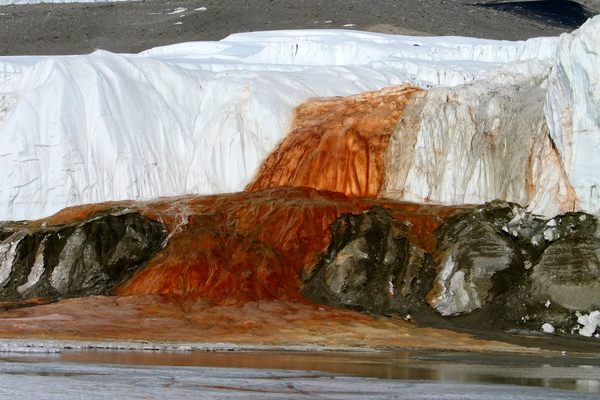Listening to Icebergs’ Loud and Mournful Breakup Songs
Scientists are just learning to decode the sounds of icebergs.

In March 2000, the iceberg B-15 broke off from the Ross Ice Shelf in Antarctica. It was the largest iceberg ever documented, with a surface area of more than 4,200 square miles—more than twice the size of the state of Delaware. After it started breaking up, the largest of its pieces, B-15a, drifted along the coast of Antarctica, lingered on a shallow seamount, and collided with an ice tongue, before running aground and breaking again. Late in 2007, the largest remaining chunk floated out into the South Pacific where, in the warmer water, it began to disintegrate.
For the whole of the next year, the ocean was noisier than usual. All the way up past the equator, 4,350 miles or so away from where B-15a broke apart, hydrophones that scientists from the National Oceanic and Atmospheric Administration (NOAA) had suspended underwater were picking up strange signals. Another set of hydrophones, this one in the Juan Fernández Islands, off the coast of Chile, picked up the noise, too, even louder. When the scientists used the two sets of data to determine the source of the noise, they found the most likely culprits: B-15a and C-19a, another giant iceberg.
Twenty years ago, not so long before B-15 broke off from Antarctica, “we didn’t even know that icebergs made noise,” says Haru Matsumoto, an ocean engineer at NOAA who has studied these sounds. But in the past few years, scientists have started to learn to distinguish the eerie, haunting sounds of iceberg life—ice cracking, icebergs grinding against each other, an iceberg grounding on the seafloor—and measure the extent to which those sounds contribute to the noise of the ocean. While they’re just now learning to listen, the sounds of ice could help them understand the behavior and breakup of icebergs and ice shelves as the poles warm up.

The U.S. military has been listening to the ocean, for the sounds of subs and ships, for decades. Even after the existence of program was made public in 1991, access to the data was still restricted. In the mid-1990s, scientists at NOAA’s Pacific Marine Environmental Laboratory deployed their own low-power hydrophone arrays to monitor the noise of ocean—they were interested, for instance, in listening to underwater earthquakes. By the end of the decade, the Comprehensive Nuclear-Test-Ban Treaty Organization also began to monitor the sounds of the ocean, for illegal nuclear explosions. They went on to share their data—including the recordings of B-15a from the Juan Fernández Islands—with NOAA scientists.
The underwater sonic data revealed an assortment of unidentified noises, including Bloop, a single, cheerful, powerful plop recorded in 1997. The mysterious signals came from the south, and NOAA scientists thought they might be icebergs. As they collected more data and started working with instruments placed in the Southern Ocean, they started hearing similar sounds over and over and soon learned to identify them. Bloop-like sounds were icequakes, made by the cracking and fracturing of large icebergs. When an iceberg splits in half or two icebergs collide, it makes what Matsumoto describes as “a very loud noise.”
“It’s—bang, bang, bang, bang,” he says. “And it happens continuously for sometimes one hour.”
An iceberg can make entirely different sounds when it scrapes the bottom of the ocean or against another iceberg. It starts vibrating, sometimes for a couple of minutes or longer—a half hour, an hour, four hours, even. It’s a ringing, soul-chilling sound that could have come from the soundtrack of an alien encounter. “That’s very distinct, and it’s very easy to tell, okay, this is an iceberg,” says Matsumoto.
One of these harmonic tremors led Douglas MacAyeal, a glaciologist at the University of Chicago, to start documenting iceberg sounds at the source. A colleague had been studying the tremors, which MacAyeal calls “strange, mournful noises,” and found that the source was a giant iceberg, C-16, that MacAyeal happened to be studying. Instead of listening from the water, MacAyeal planted four seismometers on the iceberg itself. The mournful noises, he found, were produced when C-16 scraped against another giant iceberg (B-15a, as it happened). “When icebergs scrape against each other, it’s like running your finger around the rim of a wine glass,” he says. “They’re so massive that they’ll scrape against each other for hours.”

Now that they’ve been able to locate and document the sources of these noises, to catalog and classify them, the scientists are using them to learn about the behavior of icebergs and ice shelves. The noises can provide hints about what’s happening beneath the surface of an iceberg or inside its vast mass—places that might otherwise be difficult or impossible to study safely—to create a fuller picture of what happens as the ice shelves of Antarctica and Greenland disintegrate.
“For us to figure out why the icebergs are coming off the ice shelf, we have to see and hear them coming off and know exactly when it happened,” says MacAyeal. “We know we can’t study it with satellites. Satellites look at Antarctica every six hours, and it takes a few seconds for the crack to finish. The only way to catch that crack is listening to everything all the time.”
By listening more closely to icebergs, scientists are also coming to understand just how much noise they contribute to the ocean. In one study, Matsumoto and his colleagues tracked the breakup of one iceberg and were able to show that the sound from icebergs could be contributing more to noise levels in the Southern Ocean than man-made sounds (which are extensive). The iceberg noises also occupy the same sonic bands that certain whales use to communicate, which could mean that iceberg breakups could impact marine mammals, too. It’s clear, Matsumoto says, that iceberg noise is proportional to the volume of ice in the ocean, but the scientists still aren’t exactly sure how that volume might change in the future. In other words, it’s possible that the ocean could be getting a lot noisier due to the climate change, but too soon to know for sure.
Right now, the study of iceberg sounds is still a small field, and scientists don’t even know how far the noises travel. NOAA’s northernmost hydrophone array is located at about a little north of the equator, west of Panama. “But the sound doesn’t stop there,” says Matsumoto. “It propagates northward, which means that iceberg sounds from Antarctica can be heard in the northern hemisphere as well.”
The bangs and moans of icebergs are another indication of the connectedness of Earth’s oceans. MacAyeal once found that an iceberg in Antarctica broke up, in part, because of a storm in the Gulf of Alaska more than a week earlier. When the waves from it eventually arrived in Antarctica, the iceberg flexed and bumped up and down against a shoal until it broke apart. What happens in one part of the ocean can impact the other side of the planet; if Antartica’s icebergs start making more noise, the whole ocean will feel it.














Follow us on Twitter to get the latest on the world's hidden wonders.
Like us on Facebook to get the latest on the world's hidden wonders.
Follow us on Twitter Like us on Facebook